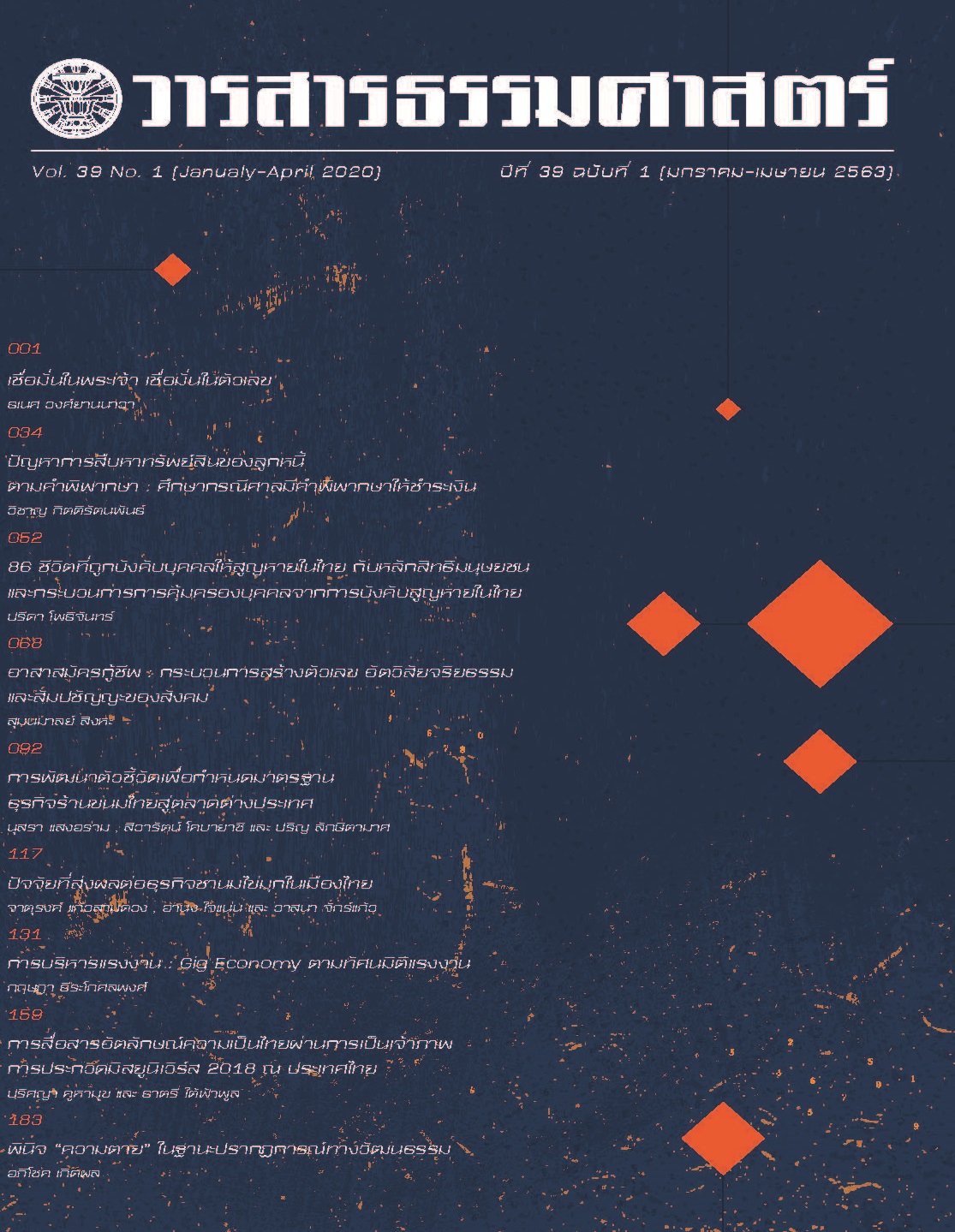เชื่อมั่นในพระเจ้า เชื่อมั่นในตัวเลข
Main Article Content
Abstract
นิธิพันธ์ วิประวิทย์ ได้เขียนไว้ในบทความ “นโยบายลูกคนเดียวกับจีนใหม่-รัฐแห่งสถิติ”
มาตรการของจีนมักต้องมีสถิติและตัวเลขเป้าหมายมาอ้างกับประชาชน ส่วนที่ว่าดีหรือไม่ ถูกใจหรือไม่ ตัวเลขน่าเชื่อถือหรือไม่ เป็นอีกเรื่อง…ไม่แน่ใจว่าชาวไทยไม่ชอบสถิติ สื่อไทยไม่สันทัด หรือรัฐบาลไทยไม่สนใจ มาตรการส่วนใหญ่ของไทยจึงไม่ค่อยมีตัวเลขทางสถิติแต่ชอบวัด(บลัฟ) กันด้วยโพล (โพสทูเดย์, 2558) สถิติเป็นเครื่องมือสำคัญในการปกครองของรัฐสมัยใหม่ (modern state) โดยเฉพาะในดินแดนยุโรปตะวันตก เมื่อพลังอาณานิคมเป็นโครงสร้างอำนาจสำคัญของโลกในครึ่งหลังศตวรรษที่สิบเก้าและศตวรรษที่ยี่สิบที่สามารถกำกับดินแดนนอกยุโรปและอเมริกาเหนือโดยพยายามเดินตามเส้นทางพัฒนาการรัฐแบบยุโรป ความพยายามที่ประสบความส าเร็จหรือไม่นั้นก็เป็นที่เห็นได้ตลอดระยะเวลาหลังการยกเลิกระบบอาณานิคม สำหรับประเทศสยาม กรมสถิติพยากรณ์ ตั้งขึ้นเมื่อ 1 เมษายน พ.ศ.2457 กรมอยู่ภายใต้กระทรวงการคลังมหาสมบัติ โดยมีกรมหมื่นพิทยาลงกรณ์เป็นอธิบดี กรมทำหน้าที่เก็บรวบรวม
ข้อมูล ตัวเลขทะเบียน รายงานต่าง ๆ ของกระทรวง ทบวง กรม แต่กว่าจะได้มีบทบาทและได้รับการยอมรับกันอย่างจริงจังเมื่อมีพระราชบัญญัติสถิติ พ.ศ.2495 เพื่อช่วยในการพัฒนาเศรษฐกิจกรมสถิติพยากรณ์ได้เปลี่ยนมาเป็นสำนักงานสถิติกลางเมื่อมีจัดตั้งสำนักงานสภาพัฒนาเศรษฐกิจแห่งชาติขึ้นอยู่กับสำนักนายกรัฐมนตรีในเดือนกันยายน พ.ศ.2502 ผลงานส าคัญคือสำมะโนประชากร 2503 จนกระทั่งเปลี่ยนสถานะมาเป็นสำนักงานสถิติแห่งชาติในวันที่ 23 พฤษภาคม
พ.ศ. 2506 สำหรับการขยายความรู้ทางสถิตินั้นคณะพาณิชยศาสตร์และการบัญชีจุฬาลงกรณ์มหาวิทยาลัย เปิดภาควิชาสถิติขึ้นเริ่มตั้งแต่ปีการศึกษา 2496 ตามหลักสูตรของพาณิชยศาสตร์บัณฑิตสาขาวิชาสถิติ
Article Details
References
ทวี แรงขำ. (2484). “ตารางชีพ” อ้างถึงใน สถิติพยากรณ์ชีพ บางเรื่อง, พิมพ์ช่วยในงานฌาปนกิจศพ นางซิว แรงขำ ณ เมรุวัดมงกุฎกษัตริยาราม วันที่ 28 เมษายน พ.ศ. 2484, หน้า 30
นิธิพันธ์ วิประวิทย์. (2558). “นโยบายลูกคนเดียวกับจีนใหม่—รัฐแห่งสถิติ”. โพสทูเดย์. สืบค้นเมื่อ 8 ตุลาคม2562, จาก https://www.posttoday.com/life/healthy/401005
อธิพรพงศ์ เกษมศรี. (2508). เหตุการณ์ที่ข้าพเจ้าได้ผ่านพบมาในอธิพรพงศ์ อนุสรณ์ พิมพ์เป็นที่ระลึกเนื่องในงานพระราชทานพระบรมราชานุเคราะห์ พระราชทานเพลิงศพหม่อมเจ้า อิทธิพรพงศ์ เกษมศรีณ เมรุหน้าพลับพลาอิศริยาภรณ์วัดเทพศิรินทราวาส วันอาทิตย์ ที่ 28 มีนาคม พ.ศ. 2508 หน้า 20
Abend, P. & Fuchs, M. (2016). Introduction the Quantified Self and Statistical Bodies. Digital Culture and Society, 2(1), p. 11.
Bröckling, U. (2016) . The Entrepreneurial Self: Fabricating a New Type of Subject, translated by Steven Black. London: Sage.
Cheney-Lippold, J. (2017) . We Are Data Algorithms and the Making of Our Digital Selves. New York: New York University Press.
Council on Foreign Relations. (2015). The Credit Rating Controversy. Retrieved from https://www.cfr.org/backgrounder/credit-rating-controversy
Curtin. I. (2018). BMI we trust: reframing the body mass index as a measure of health. Social Theory & Health, 16(3), p. 257.
Deserosières, A. (1998). The Politics of Large Numbers A History of Statistical Reasoning (p.23), translated by Camille Naish. Cambridge: Harvard University Press.
--------------------. (2002) . The Politics of Large Numbers A History of Statistical Reasoning (p.26), translated by Camille Naish. Cambridge: Harvard University Press.
Esposito, E & Stark., D. ( 2 0 1 9 ) . What’s Observed in a Rating? Rankings as Orientation in the Face of Uncertainty. Theory. Culture & Society, 36(4), 4.
--------------------. (2019). What’s Observed in a Rating? Rankings as Orientation in the Face of Uncertainty. Theory. Culture & Society, 36(4), 7-8.
--------------------. (2019). What’s Observed in a Rating? Rankings as Orientation in the Face of Uncertainty. Theory. Culture & Society, 36(4), 12.
--------------------. (2019). What’s Observed in a Rating? Rankings as Orientation in the Face of Uncertainty. Theory. Culture & Society, 36(4), 17-18.
Everett, C. (2017). Numbers and the Making of Us: Counting and the Course of Human Cultures. Cambridge: Harvard University Press.
Foucault, M. (1986). The Care of the Self: The History of Sexuality Vol. 3. New York: Pantheon Books.
Giddens, A. (1990). The Consequence of Modernity. Cambridge: Polity Press.
Hacking, I. ( 1990 ) . The Tame of Chance. Cambridge: Cambridge University Press.
Hadot, P. (2006) . The Veil of Isis: An Essay on the History of the Idea of Nature, translated by Michael Chase. Cambridge: The Belknap Press of Harvard University Press.
Heinrich, J., Heine, S. J. & Norenzayan, A. (2010). The weirdest people in the world?. Behavioral and Brain Sciences, 33(2-3), pp. 61-83.
Jeacle, I. & Carter, C. (2011) . TripAdvisor we trust: Rankings, calculative regimes and abstract systems. Accounting, Organizations and Society, 36(4), 303.
Lupton, D.(2016). The Quantified Self: A Sociology of Self-Tracking Cultures. Cambridge: Polity Press.
Mahdawi, A. (2016). Are you ready for a future where we’re all reviewed like Uber drivers. The Guardian. Retrieved from https://www.theguardian.com/technology/commentisfree/2016/mar/15/rating-culture-scorepersonal-privacy-uber-sharing-economy
Mau, S. (2019) . The Metric Society On the Quantification of the Social, translated by Sharon Howe. New York: Polity Press.
McGrath, J. E. (2004) . Loving Big Brother Performance, Privacy and Surveillance Space. London: Routledge.
Moore, P. & Robinson, A. (2016) . The quantified self: What counts in the neoliberal workplace. New Media & Society, 18(1), 2775.
Moore, P. (2018). The Quantified Self in Precarity Work, Technology and What Counts. London: Routledge.
Muller, J. Z. (2018). The Tyranny of Metrics. Princeton: Princeton University Press.
Neff, G. & Labor, V. (2012). Work and the Burden Risk in Innovative Industries. Cambridge: MIT Press.
New York: Profile Books. (2019). The Age of Surveillance Capitalism The Fight for a Human Future in the Age of Frontier of Power. New York: Profile Books.
Porter, T. M. (1995 ). Trust in Number The Pursuit of Objectivity in Science and Public Life. Princeton: Princeton University Press
--------------------. (1986). The Rise of Statistical Thinking 1820-1900. Princeton: Princeton University Press.
--------------------. (2020). The Rise of Statistical Thinking 1820-1900. Princeton: Princeton University Press.
Raeff, M. (1983) . The Well-Ordered Police State: Social and Institutional Change through Law in the Germanies and Russia, 1600-1800.
New Haven: Yale University Press.
Scheinert, C. (2016). The case for a European public credit rating agency. Retrieved from http://www.europarl.europa.eu/thinktank/en/
document.html? reference=EPRS_BRI(2016)589865
Shore, D. & Wright, S. (2000). Coercive accountability The rise of audit culture in higher education, in Audit Cultures Anthropological studies in audit, ethics, and the academy (pp. 60-61.). London: Routledge.
Stewart, K. (2012). Precarity’s Forms. Cultural Anthropology. 27(3), 518-525.
Strathern, M. (2000). New Accountabilities Anthropological studies in audit, ethics, and the academy, in Audit Cultures Anthropological studies in audit, ethics, and the academy. London: Routledge.
Tversky, B. (2019) . Mind in Motion How Action Shapes Thought. New York: Basic Books.
Zuboff, S. (2019). The Age of Surveillance Capitalism The Fight for a Human Future in the Age of Frontier of Power. New York: Profile Books.

